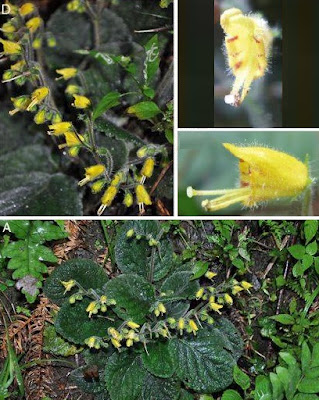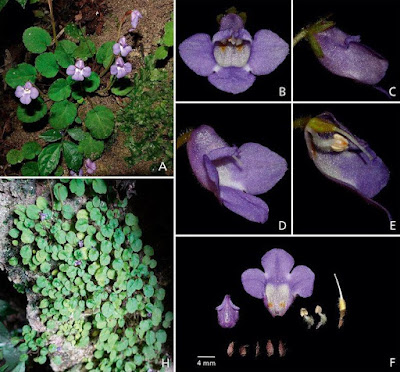[Most Recent Entries] [Calendar View]
Monday, January 15th, 2024
| Time | Event | ||
| 5:44a | [Botany • 2023] Crepidorhopalon droseroides (Linderniaceae) • A New and possibly carnivorous Species from Mozambique Abstract The new species Crepidorhopalon droseroides from Mozambique is described and illustrated. It represents the third strict Mozambique endemic in Linderniaceae, and it differs from all known species of Crepidorhopalon in the long sticky glandular hairs. The hypothesis that the species may be carnivorous is discussed. The Conservation Status is preliminarily assessed. Keywords: Crepidorhopalon droseroides, endemics, carnivory, IUCN Red List, Philcoxia, taxonomy, Eudicots Eberhard Fischer, Bart Wursten and Iain Darbyshire. 2023. A New and possibly carnivorous Species of Crepidorhopalon (Linderniaceae) from Mozambique. Phytotaxa. 603(2); 191-198. DOI: 10.11646/phytotaxa.603.2.6 Kew’s top 10 new species of 2023 Kew’s scientists and international partners share their 10 favourite new species named to science in 2023. | ||
| 8:34a | [Botany • 2019] Oreocharis rubrostriata (Gesneriaceae) • A New Species from Guangxi, China
A new species of Oreocharis Benth., Oreocharis rubrostriata F.Wen & L.E.Yang, is described and illustrated from Rongshui County, Guangxi Zhuangzu Autonomous Region, China, and a proposed conservation assessment rates the new species as Critically Endangered (CR). Key Words: Flora of Guangxi, Jiuwanshan National Natural Reserve, new taxon, Tremacron Oreocharis rubrostriata F.Wen & L.E.Yang sp. nov. ETYMOLOGY. Named for the bright red stripes in the yellow corolla. It is noticeably different from the corolla colours of the previously published Oreocharis species. VERNACULAR NAME. Hóng Wén Má Líng Jǜ Tái (红纹马铃苣苔). The first two words, “Hóng Wén”, mean red stripes, and the next four words, “Má Líng Jǜ Tái”, mean Oreocharis in Chinese. Li-E Yang, Hua-Fei Cen, Hang Sun, Michael LoFurno, Stephen Maciejewski, Winston J. Goretsky and Fang Wen. 2019. Oreocharis rubrostriata (Gesneriaceae), A New Species from Guangxi, China. Kew Bulletin. DOI: 10.1007/s12225-019-9810-9 | ||
| 8:41a | [Botany • 2019] Petrocosmea qiruniae (Gesneriaceae) • A New Species from Guizhou, China
Summary Petrocosmea qiruniae M.Q.Han, Li Bing Zhang & Yan Liu (Gesneriaceae), a new species from Guizhou, China, is described and illustrated. It is most similar to P. leiandra (W.T.Wang) Z.J.Qiu in leaf blade shape and corolla type, especially in the colour of corolla throat and spots, indumentum of the stamens and the anther and ovary morphology. It was found on humid cliffs in an enormous limestone cave called the Qingxu Cave. In addition, Petrocosmea leiandra, based on P. martini H.Lév. var. leiandra W.T.Wang, originally published with very few descriptive data, is supplemented with more morphological data and a revised description. Key Words: Lamiales, Limestone, caves, taxonomy Petrocosmea qiruniae M.Q.Han, Li Bing Zhang & Yan Liu sp. nov. ETYMOLOGY. The specific epithet commemorates Miss Qi-Run He, a friend of the first author. Her Chinese pinyin name "Qi-Run" means “incomparable fine jade” perfectly representing the characteristics of this new Petrocosmea. Meng-Qi Han, Quan Yuan, Tian-Feng Lü, Li-Bing Zhang and Yan Liu. 2019. Petrocosmea qiruniae (Gesneriaceae), A New Species from Guizhou, China with Supplementary Data and Revised Description of P. leiandra. Kew Bulletin. 74:22. DOI: 10.1007/s12225-019-9811-8 | ||
| 9:47a | [Botany • 2023] Chamaelirium jiuwanshanense (Melanthiaceae) • A New dioecious Species from Guangxi, China
Abstract Chamaelirium jiuwanshanense, a new dioecious species of Melanthiaceae from Jiuwanshan National Nature Reserve, Guangxi, China is described and illustrated. It is similar to C. shimentaiense, but can be clearly distinguished from the latter mainly by its dioecious sexual system, linear-lanceolate bract-like cauline leaves, racemes with pedicelled flowers, etc. A detailed morphological description, and the information on its distribution, habitat and conservation status are provided here. Keyword: Chamaelirium shimentaiense, Dioecious, Flora of Guangxi, Melanthiaceae, New taxon, Taxonomy Chamaelirium jiuwanshanense Ying Qin & Yan Liu, sp. nov. 九万山白丝草 Chamaelirium jiuwanshanense is similar to C. shimentaiense Y.H.Tong, C.M.He & Y.Q.Li, but differs from the latter mainly by its dioecious (vs. hermaphroditic) sexual system, linear-lanceolate (vs. elliptic) bract-like cauline leaves, racemose (vs. spicate) inflorescences, flowers with distinct pedicels (vs. sessile or subsessile), and greenish, dark-greenish, or purplish-brown tepals (vs. purplish). Ying Qin, Fei Tan, Yu Song Huang and Yan Liu. 2023. Chamaelirium jiuwanshanense (Melanthiaceae), A New dioecious Species from Guangxi, China. Taiwania. 68(1); 97-100. DOI: 10.6165/tai.2023.68.97 九万山发现2个植物新种 |
| << Previous Day |
2024/01/15 [Calendar] |
Next Day >> |









